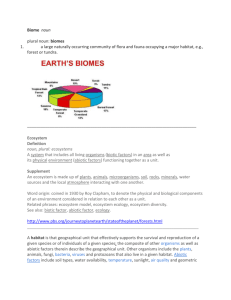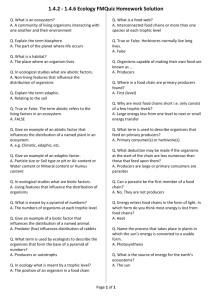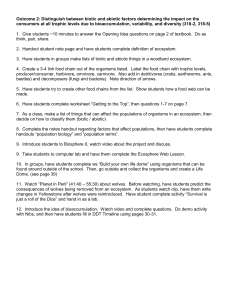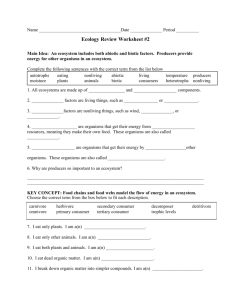What is ecology?
advertisement
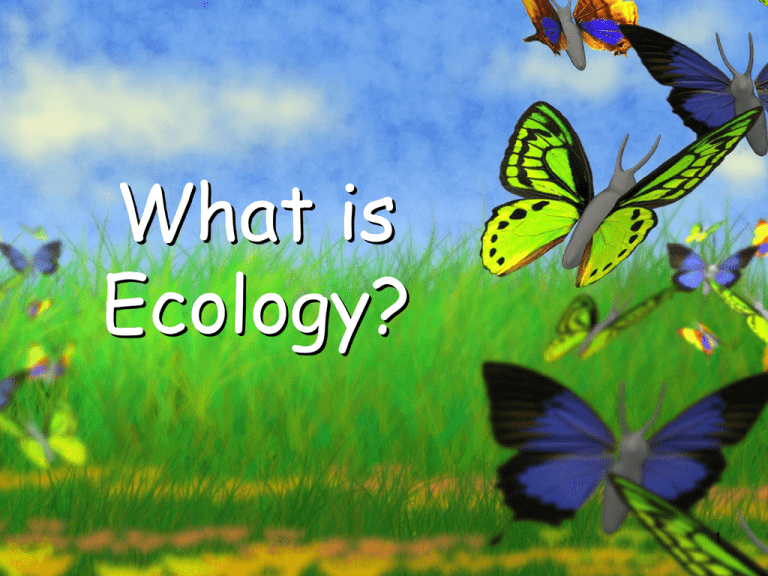
What is Ecology? 1 Organisms and Their Environment 2 What is Ecology?? • The study of interactions that take place between organisms and their environment. • It explains how living organisms affect each other and the world they live in. 3 Levels of Organization 4 What are the Simplest Levels? • Atom • Molecule • Organelle • Cell • Tissue • Organ • System 5 Levels of Organization • Ecologists have organized the interactions an organism takes part in into different levels according to complexity. 6 1. The Cell • Basic unit of life. copyright cmassengale 7 2. Tissues • A group of specialized cells working together for a specific purpose copyright cmassengale 8 3. Organs • a group of tissues working together to perform a vital function in living organisms. copyright cmassengale 9 4. Organ system • A group of organs working together to perform a specific function. copyright cmassengale 10 5. Organism • An individual living thing that is made of cells, uses energy, reproduces, responds, grows, and develops 11 6. Population • A group of organisms, all of the same species, which interbreed and live in the same place at the same time. 12 7. Community • All the populations of different species that live in the same place at the same time. 13 8. Ecosystem (Biomes) • Populations of plants and animals that interact with each other in a given area with the abiotic components of that area. (terrestrial or aquatic) 14 9. Biosphere • The portion of Earth that supports life. 15 What level of organization? Organism 16 What level of Organization? Community 17 What level of Organization? Population 18 Habitat & Niche • Habitat is the place a plant or animal lives • Niche is an organism’s total way of life (It’s their job) 19 The Nonliving Environment • Abiotic factors the nonliving parts of an organism’s environment. • Examples include air currents, temperature, moisture, light, and soil. • Abiotic factors affect an organism’s life. 20 The Living Environment • Biotic factors- all the living organisms that inhabit an environment. • All organisms depend on others directly or indirectly for food, shelter, reproduction, or protection. 21 Abiotic or Biotic? Biotic 22 Abiotic or Biotic? Abiotic 23 Abiotic or Biotic? Abiotic 24 Abiotic or Biotic? Biotic 25 Energy Flow in an Ecosystem 26 Energy Flow • Energy in an ecosystem originally comes from the sun • Energy flows through Ecosystems from producers to consumers – Producers (make food) – Consumers (use food by eating producers or other consumers) 27 Producers • Sunlight is the main source of energy for most life on earth. • Producers contain chlorophyll & can use energy directly from the sun 28 Autotrophs • An Autotroph is any organism that can produce its own food supply! • Autotrophs are also called Producers • Plants, algae, some protists, & some bacteria are examples 29 Niche of a Producer • Captures energy and transforms it into organic, stored energy for the use of living organisms. • May be photoautotrophs using light energy (e.g. plants) • May be chemoautotrophs using chemical energy (e.g. cyanobacteria) 30 Photoautotroph Producer That Captures Energy from the sun by: –Photosynthesis • Adds Oxygen to the atmosphere • Removes Carbon Dioxide from the Atmosphere Algae 31 Habitat of Photoautotrophs • On Land –Plants • In The Sea –Algae (Protists) • Tidal Flats & Salt Marshes –Cyanobacteria 32 Organisms that can make glucose during photosynthesis are called PRODUCERS. 33 Producers use most of the energy they make for themselves. 34 The energy that is not used by producers can be passed on to organisms that cannot make their own energy. 35 Organisms that cannot make their own energy are called CONSUMERS. 36 Consumers Heterotrophs eat other organisms to obtain energy. (e.g. animals) • Herbivores – Eat Only Plants • Carnivores – Eat Only Other Animals 37 Consumers Heterotrophs eat other organisms to obtain energy. • Omnivores (Humans) – Eat Plants & Animals • Detritivores (Scavengers) – Feed On Dead Plant & Animal Remains (buzzards) • Decomposers – Break down dead material into Reusable nutrients. 38 Feeding Relationships Energy flows through an ecosystem in one direction from producers to various levels of consumers 39 Feeding Relationships • Food Chain –Simple Energy path through an ecosystem • Food Web –More realistic path through an ecosystem made of many food chains 40 Food Chain Primary Consumer Secondary Consumer Tertiary consumer Quaternary Consumer Producer (trapped sunlight & stored food) 41 Consumers that eat producers to get energy: •Are primary consumers •Are herbivores (plant-eaters) 42 ONLY 10% of the energy gets passed from one level to the next. 43 10% Rule • Notice that only about 10% of the energy goes from one level to the next. • Only 10% of the energy in primary producers gets transferred to energy in primary consumers. • The rest goes into metabolism, growth, and waste. 44 A Consumer that Eats Another Consumer for Energy: •Is called a secondary consumer •May be a carnivore or a omnivore •May be a predator •May be a scavenger 45 Most of the energy the secondary consumer gets from the primary consumer is used by the secondary consumer. 46 Some of the energy is lost as heat, but some energy is stored and can be passed on to another consumer. 47 A consumer that eats a consumer that already ate a consumer: •Is called a tertiary consumer •May be a carnivore or a omnivore •May be a predator •May be a scavenger 48 Name the Producer, Consumers & Decomposers in this food chain: 49 The transfer of energy from the sun to producer to primary consumer then to higher order consumers can be shown in a FOOD CHAIN. 50 Food Chains Show Available Energy 51 More Food Chains 52 Food Webs: •Are interconnected food chains •They show the feeding relationships in an ecosystem 53 Food Web 54 55 T. Trimpe 2008 http://sciencespot.net/ http://www.mos.org/oceans/graphics/life/foodchain.jpg Use the food web to answer these questions. 1. What are the producers? 2. Name two organisms that are herbivores. 3. Name one organism that is a carnivore. 4. What would happen to the snake population if the hawk were removed? Image: http://weedeco.msu.montana.edu/class/LRES443/Lectures/Lecture20/FoodWeb.JPG The answers are … 1. What are the producers? Oak Tree & Pine Tree 2. Name two organisms that are herbivores. Pine Borer & Mouse 3. Name one organism that is a carnivore. Salamander, Kinglet, Snake, or Hawk 4. What would happen to the snake population if the hawk were removed? Image: http://weedeco.msu.montana.edu/class/LRES443/Lectures/Lecture20/FoodWeb.JPG Since there would be more mice and birds, we would expect the snake population to increase. Trophic (Energy) Levels Each Level In A Food Chain or Food Web is a Trophic Level. Producers – Always The First Trophic Level – How Energy Enters The System • Herbivores – Second Trophic Level 59 Trophic Levels • Carnivores/Omnivores –Make Up The Remaining Trophic Levels Each level depends on the one below it for energy. 60 Ecological Pyramids Graphic Representations Of The Relative Amounts of Energy or Matter At Each Trophic Level May be: Energy Pyramid Biomass Pyramid Pyramid of Numbers 61 Another way of showing the transfer of energy in an ecosystem is the ENERGY PYRAMID 62 Energy Pyramids Show •Amount of available energy decreases for higher consumers •Amount of available energy decreases down the food chain •It takes a large number of producers to support a small number of primary consumers •It takes a large number of primary consumers to support a small number of secondary consumers 63 Energy Pyramids Show •Amount of available energy decreases for higher consumers •Amount of available energy decreases down the food chain “Hoot” “Hoot” “Did anybody •It takes a large number see me hiding?” of producers to support a small number of primary consumers •It takes a large number of primary consumers to support a small number of secondary consumers 64 65 Energy Pyramid 66 Biomass Pyramid 67 Pyramid of Numbers 68 Ecology Quiz • 1. The study of interactions that take place between organisms and their environment is called – A. Zoology B. Chemistry C. Ecology • 2. Put the following in correct order from 1st (Smallest Eco. ) Level to 5th (Largest Level) – Biosphere, Community, Organism, Population, and Ecosystem • 3. Label the following food chain correctly -PRODUCER -PRIMARY CONSUMER -SECONDARY CONSUMER -ULTIMATE SOURCE OF ENERGY 69



